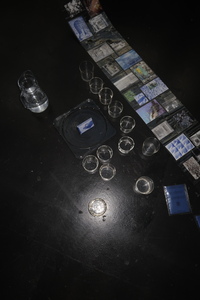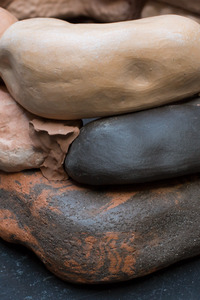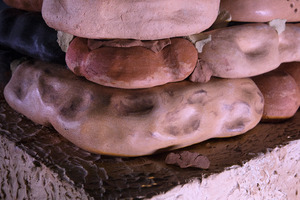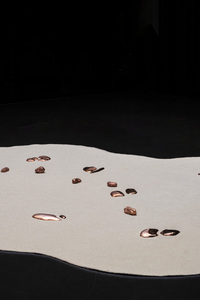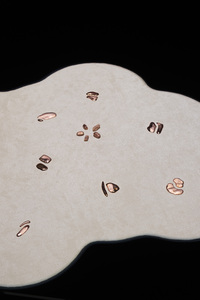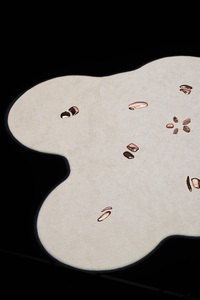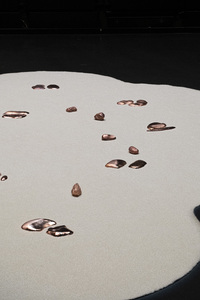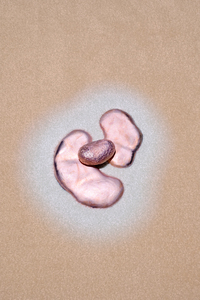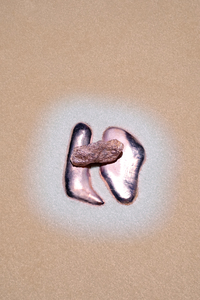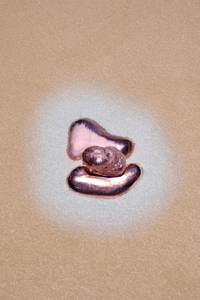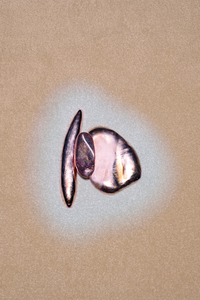"Detailansicht"
| Begriff | Detailansicht |
| Metakey | Beziehung/Funktion (media_object:relationship) |
| Typ | Keyword |
| Vokabular | Medienobjekt |
35 Inhalte
- Seite 1 von 3
Brunnen Geschichten
- Titel
- Brunnen Geschichten
- Autor/in
- Beschreibung (de)
- Die Foto-Installation wurde im Rahmen eines Seminars „A Photo Book in Two Parts“ im Bereich Kommunikationsdesign im Wintersemester 2023/2024 erarbeitet und von dem Grafik- und Fotodesignstudio „Europium“ betreut. Die Gastdozierenden Ghazaal Vojdani und Julia Andréone hat die Studierenden dazu angeleitet, Mikro-Ereignisse, die spezifisch in der Stadt Karlsruhe auftreten, zu entdecken. Diese Narrative werden in Verbindung mit gefundenen Fotografien erzählt.
Karlsruhe verfügt über bis zu 300 offizielle Brunnen. In den urbanen Räumen, in denen diese Brunnen installiert sind, wachsen unbemerkt Flechten in unterschiedlichen Farben und Formen. Während sich diese Flechten langsam ausbreiten, bilden sich gleichzeitig informelle Gemeinschaften von Menschen, die sich rund um diese Brunnen versammeln. Alle diese Begegnungen entstehen auf Grundlage der zirkulären Wasserquelle, die die Brunnen darstellen.
Die Geschichte wird anhand von Archivfotografien erzählt. Die Fotografien der Installation wurden bearbeitet und anschließend im RISO-Druckverfahren sowie durch Laserdruck reproduziert. Auf der Rückseite der Fotografien befinden sich Textfragmente, die sich mit den Themen Brunnen, Flechten, Gemeinschaften und Wasser auseinandersetzen. Diese Texte helfen den Betrachtern, eine Erzählung zu den abgebildeten Fotografien zu entwickeln.
Die Fotografien befinden sich in Plastiktaschen, die einen fünf Meter langen Vorhang bilden. Dieser hängt an einem Stahlträger und fällt flach zu Boden. Der Vorhang symbolisiert das Narrativ des Wasserstrahls, entlang dessen sich die Mikro-Phänomene ereignen, wie die Bildung von Gemeinschaften rund um Brunnen und das Wachsen von Flechten auf Gestein. Am Fuße des Vorhangs befinden sich gefüllte Wassergläser und eine Karaffe, die zum Trinken einladen. Diese Elemente fördern neue Begegnungen und Gespräche zwischen den Betrachtern.
Die Installation wurde erstmals am 14. Februar 2024 während des Präsentationstags des Fachbereichs Kommunikationsdesign ausgestellt.
- Die Foto-Installation wurde im Rahmen eines Seminars „A Photo Book in Two Parts“ im Bereich Kommunikationsdesign im Wintersemester 2023/2024 erarbeitet und von dem Grafik- und Fotodesignstudio „Europium“ betreut. Die Gastdozierenden Ghazaal Vojdani und Julia Andréone hat die Studierenden dazu angeleitet, Mikro-Ereignisse, die spezifisch in der Stadt Karlsruhe auftreten, zu entdecken. Diese Narrative werden in Verbindung mit gefundenen Fotografien erzählt.
- Beschreibung (en)
- The photo installation was developed as part of a seminar "A Photo Book in Two Parts" in communication design in the winter semester 2023/2024 and supervised by the graphic and photo design studio Europium. Guest lecturers Ghazaal Vojdani and Julia Andréone guided the students to discover micro-events that occur specifically in the city of Karlsruhe. These narratives are told in conjunction with found images.
Karlsruhe has up to 300 official fountains. In the urban spaces where these fountains are installed, lichens of different colors and shapes grow unnoticed. As these lichens slowly spread, informal communities of people gather around these fountains. All these encounters are based on the circular water source that the fountains represent.
The story is told through archival photographs. The photographs of the installation were edited and then reproduced using the RISO printing process and laser printing. On the back of the photographs are text fragments that deal with the themes of fountains, lichen, communities and water. These texts help the viewer to develop a narrative about the photographs depicted.
The photographs are in plastic bags that form a five-meter-long curtain. This hangs from a steel girder and falls flat to the floor. The curtain symbolizes the narrative of the water stream along which the micro-phenomena take place, such as the formation of communities around fountains and the growth of lichen on rock. At the foot of the curtain are filled glasses of water and a carafe that invite people to drink. These elements encourage new encounters and conversations between viewers.
The installation was first exhibited on February 14, 2024 during the Communication Design department's presentation day.
- The photo installation was developed as part of a seminar "A Photo Book in Two Parts" in communication design in the winter semester 2023/2024 and supervised by the graphic and photo design studio Europium. Guest lecturers Ghazaal Vojdani and Julia Andréone guided the students to discover micro-events that occur specifically in the city of Karlsruhe. These narratives are told in conjunction with found images.
- Kategorie
- Typ des Projekts/Werks
- Schlagworte
- Datierung
- 14.02.2024
- Sprache
- Material
- Technik/Verfahren/Formate
- Risographie
- Abmessungen
- 5m x 2m x 3m
- Ort: Institution
- Ort
- Lichthof 1
- Stadt
- Land
- Beteiligte Institution(en)
- Titel
- Brunnen Geschichten
- Titel (en)
- Fountain Stories
- Urheberrechtshinweis
- © Staatliche Hochschule für Gestaltung Karlsruhe
- Rechtsschutz/Lizenz
- Freigabe Nutzung HfG
- Medienersteller/in
- Beziehung/Funktion
- Medien-Beschreibung
- Die Foto-Installation wurde im Rahmen eines Seminars „A Photo Book in Two Parts“ im Bereich Kommunikationsdesign im Wintersemester 2023/2024 erarbeitet und von dem Grafik- und Fotodesignstudio „Europium“ betreut. Die Gastdozierenden Ghazaal Vojdani und Julia Andréone hat die Studierenden dazu angeleitet, Mikro-Ereignisse, die spezifisch in der Stadt Karlsruhe auftreten, zu entdecken. Diese Narrative werden in Verbindung mit gefundenen Fotografien erzählt.
Karlsruhe verfügt über bis zu 300 offizielle Brunnen. In den urbanen Räumen, in denen diese Brunnen installiert sind, wachsen unbemerkt Flechten in unterschiedlichen Farben und Formen. Während sich diese Flechten langsam ausbreiten, bilden sich gleichzeitig informelle Gemeinschaften von Menschen, die sich rund um diese Brunnen versammeln. Alle diese Begegnungen entstehen auf Grundlage der zirkulären Wasserquelle, die die Brunnen darstellen.
Die Geschichte wird anhand von Archivfotografien erzählt. Die Fotografien der Installation wurden bearbeitet und anschließend im RISO-Druckverfahren sowie durch Laserdruck reproduziert. Auf der Rückseite der Fotografien befinden sich Textfragmente, die sich mit den Themen Brunnen, Flechten, Gemeinschaften und Wasser auseinandersetzen. Diese Texte helfen den Betrachtern, eine Erzählung zu den abgebildeten Fotografien zu entwickeln.
Die Fotografien befinden sich in Plastiktaschen, die einen fünf Meter langen Vorhang bilden. Dieser hängt an einem Stahlträger und fällt flach zu Boden. Der Vorhang symbolisiert das Narrativ des Wasserstrahls, entlang dessen sich die Mikro-Phänomene ereignen, wie die Bildung von Gemeinschaften rund um Brunnen und das Wachsen von Flechten auf Gestein. Am Fuße des Vorhangs befinden sich gefüllte Wassergläser und eine Karaffe, die zum Trinken einladen. Diese Elemente fördern neue Begegnungen und Gespräche zwischen den Betrachtern.
The photo installation was developed as part of a seminar "A Photo Book in Two Parts" in communication design in the winter semester 2023/2024 and supervised by the graphic and photo design studio Europium. Guest lecturers Ghazaal Vojdani and Julia Andréone guided the students to discover micro-events that occur specifically in the city of Karlsruhe. These narratives are told in conjunction with found images.
Karlsruhe has up to 300 official fountains. In the urban spaces where these fountains are installed, lichens of different colors and shapes grow unnoticed. As these lichens slowly spread, informal communities of people gather around these fountains. All these encounters are based on the circular water source that the fountains represent.
The story is told through archival photographs. The photographs of the installation were edited and then reproduced using the RISO printing process and laser printing. On the back of the photographs are text fragments that deal with the themes of fountains, lichen, communities and water. These texts help the viewer to develop a narrative about the photographs depicted.
The photographs are in plastic bags that form a five-meter-long curtain. This hangs from a steel girder and falls flat to the floor. The curtain symbolizes the narrative of the water stream along which the micro-phenomena take place, such as the formation of communities around fountains and the growth of lichen on rock. At the foot of the curtain are filled glasses of water and a carafe that invite people to drink. These elements encourage new encounters and conversations between viewers.
Die Installation wurde einmalig am 14. Februar 2024 zusammen mit den anderen Projekten des Seminars „A Photo Book in Two Parts“ im Lichthof Eins während des Präsentationstags des Fachbereichs Kommunikationsdesign ausgestellt.
- Die Foto-Installation wurde im Rahmen eines Seminars „A Photo Book in Two Parts“ im Bereich Kommunikationsdesign im Wintersemester 2023/2024 erarbeitet und von dem Grafik- und Fotodesignstudio „Europium“ betreut. Die Gastdozierenden Ghazaal Vojdani und Julia Andréone hat die Studierenden dazu angeleitet, Mikro-Ereignisse, die spezifisch in der Stadt Karlsruhe auftreten, zu entdecken. Diese Narrative werden in Verbindung mit gefundenen Fotografien erzählt.
- Medien-Beschreibung (en)
- The photo installation was developed as part of a seminar "A Photo Book in Two Parts" in communication design in the winter semester 2023/2024 and supervised by the graphic and photo design studio Europium. Guest lecturers Ghazaal Vojdani and Julia Andréone guided the students to discover micro-events that occur specifically in the city of Karlsruhe. These narratives are told in conjunction with found images.
Karlsruhe has up to 300 official fountains. In the urban spaces where these fountains are installed, lichens of different colors and shapes grow unnoticed. As these lichens slowly spread, informal communities of people gather around these fountains. All these encounters are based on the circular water source that the fountains represent.
The story is told through archival photographs. The photographs of the installation were edited and then reproduced using the RISO printing process and laser printing. On the back of the photographs are text fragments that deal with the themes of fountains, lichen, communities and water. These texts help the viewer to develop a narrative about the photographs depicted.
The photographs are in plastic bags that form a five-meter-long curtain. This hangs from a steel girder and falls flat to the floor. The curtain symbolizes the narrative of the water stream along which the micro-phenomena take place, such as the formation of communities around fountains and the growth of lichen on rock. At the foot of the curtain are filled glasses of water and a carafe that invite people to drink. These elements encourage new encounters and conversations between viewers.
The installation was exhibited once on February 14, 2024 together with the other projects of the seminar “A Photo Book in Two Parts” in the atrium (one) during the presentation day of the Department of Communication Design.
- The photo installation was developed as part of a seminar "A Photo Book in Two Parts" in communication design in the winter semester 2023/2024 and supervised by the graphic and photo design studio Europium. Guest lecturers Ghazaal Vojdani and Julia Andréone guided the students to discover micro-events that occur specifically in the city of Karlsruhe. These narratives are told in conjunction with found images.
- Alternativ-Text (de)
- Detailaufnahme des zu Boden fallenden Plastikvorhangs mit den Photographien.
- Alternativ-Text (en)
- Close-up of the plastic curtain with the photographs falling to the floor.
- Projektleiter/in
- Semester
- Studiengang
- Lehrveranstaltung
- Importiert am
- 14.02.2024
- Übergeordnete Sets
- 1
Brunnen des wahren Glaubens
- Titel
- Brunnen des wahren Glaubens
- Autor/in
- Kategorie
- Titel
- Brunnen des wahren Glaubens
- Titel (en)
- Well of True Belief
- Urheberrechtshinweis
- © Jannis Zell
- Rechtsschutz/Lizenz
- Freigabe Nutzung HfG
- Medienersteller/in
- Beziehung/Funktion
- Medien-Beschreibung
- "Obwohl wir in einer technologisch fortgeschrittenen Gesellschaft leben, ist der Aberglaube so weit verbreitet wie eh und je. Aberglaube ist das natürliche Ergebnis mehrerer gut verstandener psychologischer Prozesse, darunter unsere menschliche Sensibilität für Zufälle, eine Vorliebe für die Entwicklung von Ritualen, um die Zeit zu füllen (um die Nerven, die Ungeduld oder beides zu bekämpfen), unsere Bemühungen, mit Unsicherheiten umzugehen, das Bedürfnis nach Kontrolle und vieles mehr."
-Believing in Magic: The Psychology of Superstition, Stuart A. Vyse. (eigene Übersetzung)
Der Brunnen des wahren Glaubens ist ein digitaler Wunschbrunnen. Er ist das erste Denkmal, das auf dem Mars errichtet wurde.
Jetzt wünschen wir uns Nebel und Tropfen und Pfützen und dass der rote Boden durchnässt wird. Nach Flaschen und Duschen und Toiletten und Fensterputzern und Coca Cola light mit Eiswürfeln; nach Schwimmen und Suppe und Pools und Brunnen und Quellen.
Modell: 60 × 126 × 83 cm Styropor, Gips, Ton, Pigmente
- "Obwohl wir in einer technologisch fortgeschrittenen Gesellschaft leben, ist der Aberglaube so weit verbreitet wie eh und je. Aberglaube ist das natürliche Ergebnis mehrerer gut verstandener psychologischer Prozesse, darunter unsere menschliche Sensibilität für Zufälle, eine Vorliebe für die Entwicklung von Ritualen, um die Zeit zu füllen (um die Nerven, die Ungeduld oder beides zu bekämpfen), unsere Bemühungen, mit Unsicherheiten umzugehen, das Bedürfnis nach Kontrolle und vieles mehr."
- Medien-Beschreibung (en)
- “Although we live in a technologically advanced society, superstition is as widespread as it has ever been. Superstitions, are the natural result of several well-understood psychological processes, including our human sensitivity to coincidence, a penchant for developing rituals to fill time (to battle nerves, impatience, or both), our efforts to cope with uncertainty, the need for control, and more.”
-Believing in Magic: The Psychology of Superstition, Stuart A. Vyse.
The Well of True Belief is a digital wishing well. It is the first monument to have been erected on Mars. shifting boundaries between our bodies and the external world.
Now we wish for fog and drips and drops and puddles and for the red ground to get soaked. For bottles and showers and toilets and window cleaners and Coca Cola light with ice cubes; for swimming and soup and pools and fountains and wells.
Model: 60 × 126 × 83 cm Styrofoam, gypsum, clay, pigments
- “Although we live in a technologically advanced society, superstition is as widespread as it has ever been. Superstitions, are the natural result of several well-understood psychological processes, including our human sensitivity to coincidence, a penchant for developing rituals to fill time (to battle nerves, impatience, or both), our efforts to cope with uncertainty, the need for control, and more.”
- Projektleiter/in
- Semester
- Studiengang
- Typ der Abschlussarbeit
- Importiert am
- 31.07.2024
- Übergeordnete Sets
- 1
Brunnen des wahren Glaubens
- Titel
- Brunnen des wahren Glaubens
- Autor/in
- Kategorie
- Titel
- Brunnen des wahren Glaubens
- Titel (en)
- Well of True Belief
- Urheberrechtshinweis
- © Jannis Zell
- Rechtsschutz/Lizenz
- Freigabe Nutzung HfG
- Medienersteller/in
- Beziehung/Funktion
- Medien-Beschreibung
- "Obwohl wir in einer technologisch fortgeschrittenen Gesellschaft leben, ist der Aberglaube so weit verbreitet wie eh und je. Aberglaube ist das natürliche Ergebnis mehrerer gut verstandener psychologischer Prozesse, darunter unsere menschliche Sensibilität für Zufälle, eine Vorliebe für die Entwicklung von Ritualen, um die Zeit zu füllen (um die Nerven, die Ungeduld oder beides zu bekämpfen), unsere Bemühungen, mit Unsicherheiten umzugehen, das Bedürfnis nach Kontrolle und vieles mehr."
-Believing in Magic: The Psychology of Superstition, Stuart A. Vyse. (eigene Übersetzung)
Der Brunnen des wahren Glaubens ist ein digitaler Wunschbrunnen. Er ist das erste Denkmal, das auf dem Mars errichtet wurde.
Jetzt wünschen wir uns Nebel und Tropfen und Pfützen und dass der rote Boden durchnässt wird. Nach Flaschen und Duschen und Toiletten und Fensterputzern und Coca Cola light mit Eiswürfeln; nach Schwimmen und Suppe und Pools und Brunnen und Quellen.
Modell: 60 × 126 × 83 cm Styropor, Gips, Ton, Pigmente
- "Obwohl wir in einer technologisch fortgeschrittenen Gesellschaft leben, ist der Aberglaube so weit verbreitet wie eh und je. Aberglaube ist das natürliche Ergebnis mehrerer gut verstandener psychologischer Prozesse, darunter unsere menschliche Sensibilität für Zufälle, eine Vorliebe für die Entwicklung von Ritualen, um die Zeit zu füllen (um die Nerven, die Ungeduld oder beides zu bekämpfen), unsere Bemühungen, mit Unsicherheiten umzugehen, das Bedürfnis nach Kontrolle und vieles mehr."
- Medien-Beschreibung (en)
- “Although we live in a technologically advanced society, superstition is as widespread as it has ever been. Superstitions, are the natural result of several well-understood psychological processes, including our human sensitivity to coincidence, a penchant for developing rituals to fill time (to battle nerves, impatience, or both), our efforts to cope with uncertainty, the need for control, and more.”
-Believing in Magic: The Psychology of Superstition, Stuart A. Vyse.
The Well of True Belief is a digital wishing well. It is the first monument to have been erected on Mars. shifting boundaries between our bodies and the external world.
Now we wish for fog and drips and drops and puddles and for the red ground to get soaked. For bottles and showers and toilets and window cleaners and Coca Cola light with ice cubes; for swimming and soup and pools and fountains and wells.
Model: 60 × 126 × 83 cm Styrofoam, gypsum, clay, pigments
- “Although we live in a technologically advanced society, superstition is as widespread as it has ever been. Superstitions, are the natural result of several well-understood psychological processes, including our human sensitivity to coincidence, a penchant for developing rituals to fill time (to battle nerves, impatience, or both), our efforts to cope with uncertainty, the need for control, and more.”
- Projektleiter/in
- Semester
- Studiengang
- Typ der Abschlussarbeit
- Importiert am
- 31.07.2024
- Übergeordnete Sets
- 1
finding traces and placing connections - Detailansicht
- Titel
- finding traces and placing connections - Detailansicht
- Autor/in
- Schlagworte
- Titel
- finding traces and placing connections - Detailansicht
- Urheberrechtshinweis
- © Sören Göbel
- Freigabe Nutzung HfG
- Medienersteller/in
- Beziehung/Funktion
- Projektleiter/in
- Semester
- Studiengang
- Typ der Abschlussarbeit
- Importiert am
- 20.01.2025
- Übergeordnete Sets
- 1
finding traces and placing connections - Detailansicht
- Titel
- finding traces and placing connections - Detailansicht
- Autor/in
- Schlagworte
- Titel
- finding traces and placing connections - Detailansicht
- Urheberrechtshinweis
- © Sören Göbel
- Freigabe Nutzung HfG
- Medienersteller/in
- Beziehung/Funktion
- Projektleiter/in
- Semester
- Studiengang
- Typ der Abschlussarbeit
- Importiert am
- 20.01.2025
- Übergeordnete Sets
- 1
finding traces and placing connections - Detailansicht
- Titel
- finding traces and placing connections - Detailansicht
- Autor/in
- Schlagworte
- Titel
- finding traces and placing connections - Detailansicht
- Urheberrechtshinweis
- © Sören Göbel
- Freigabe Nutzung HfG
- Medienersteller/in
- Beziehung/Funktion
- Projektleiter/in
- Semester
- Studiengang
- Typ der Abschlussarbeit
- Importiert am
- 20.01.2025
- Übergeordnete Sets
- 1
finding traces and placing connections - Detailansicht
- Titel
- finding traces and placing connections - Detailansicht
- Autor/in
- Schlagworte
- Titel
- finding traces and placing connections - Detailansicht
- Urheberrechtshinweis
- © Sören Göbel
- Freigabe Nutzung HfG
- Medienersteller/in
- Beziehung/Funktion
- Projektleiter/in
- Semester
- Studiengang
- Typ der Abschlussarbeit
- Importiert am
- 20.01.2025
- Übergeordnete Sets
- 1
finding traces and placing connections - Detailansicht
- Titel
- finding traces and placing connections - Detailansicht
- Autor/in
- Schlagworte
- Titel
- finding traces and placing connections - Detailansicht
- Urheberrechtshinweis
- © Sören Göbel
- Freigabe Nutzung HfG
- Medienersteller/in
- Beziehung/Funktion
- Projektleiter/in
- Semester
- Studiengang
- Typ der Abschlussarbeit
- Importiert am
- 20.01.2025
- Übergeordnete Sets
- 1
finding traces and placing connections - copper connections
- Titel
- finding traces and placing connections - copper connections
- Autor/in
- Schlagworte
- Titel
- finding traces and placing connections - copper connections
- Urheberrechtshinweis
- © Sören Göbel
- Freigabe Nutzung HfG
- Medienersteller/in
- Beziehung/Funktion
- Medien-Beschreibung
- Detailansicht der Kupfer Elemente.
- Medien-Beschreibung (en)
- Detail view of the copper connections.
- Projektleiter/in
- Semester
- Studiengang
- Typ der Abschlussarbeit
- Importiert am
- 20.01.2025
- Übergeordnete Sets
- 1
finding traces and placing connections - copper connections
- Titel
- finding traces and placing connections - copper connections
- Autor/in
- Schlagworte
- Titel
- finding traces and placing connections - copper connections
- Urheberrechtshinweis
- © Sören Göbel
- Freigabe Nutzung HfG
- Medienersteller/in
- Beziehung/Funktion
- Medien-Beschreibung
- Detailansicht der Kupfer Elemente.
- Medien-Beschreibung (en)
- Detail view of the copper connections.
- Projektleiter/in
- Semester
- Studiengang
- Typ der Abschlussarbeit
- Importiert am
- 20.01.2025
- Übergeordnete Sets
- 1
finding traces and placing connections - copper connections
- Titel
- finding traces and placing connections - copper connections
- Autor/in
- Schlagworte
- Titel
- finding traces and placing connections - copper connections
- Urheberrechtshinweis
- © Sören Göbel
- Freigabe Nutzung HfG
- Medienersteller/in
- Beziehung/Funktion
- Medien-Beschreibung
- Detailansicht der Kupfer Elemente.
- Medien-Beschreibung (en)
- Detail view of the copper connections.
- Projektleiter/in
- Semester
- Studiengang
- Typ der Abschlussarbeit
- Importiert am
- 20.01.2025
- Übergeordnete Sets
- 1
finding traces and placing connections - copper connections
- Titel
- finding traces and placing connections - copper connections
- Autor/in
- Schlagworte
- Titel
- finding traces and placing connections - copper connections
- Urheberrechtshinweis
- © Sören Göbel
- Freigabe Nutzung HfG
- Medienersteller/in
- Beziehung/Funktion
- Medien-Beschreibung
- Detailansicht der Kupfer Elemente.
- Medien-Beschreibung (en)
- Detail view of the copper connections.
- Projektleiter/in
- Semester
- Studiengang
- Typ der Abschlussarbeit
- Importiert am
- 20.01.2025
- Übergeordnete Sets
- 1
